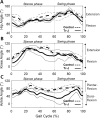Gait parameters as tools for analyzing phenotypic alterations of a mouse model of Charcot-Marie-Tooth disease
- PMID: 33717412
- PMCID: PMC7935128
- DOI: 10.1080/19768354.2021.1880967
Gait parameters as tools for analyzing phenotypic alterations of a mouse model of Charcot-Marie-Tooth disease
Abstract
Charcot-Marie-Tooth disease (CMT), a genetically heterogeneous group of diseases in the peripheral nervous system, is characterized by progressive and symmetrical distal weakness resulting in gait abnormality. The necessity of the diagnostic and prognostic biomarkers has been raised for both basic research and clinical practice in CMT. Since biomarkers for animal study of CMT are limited, we evaluated the feasibility of gait parameters as tool for measuring disease phenotype of CMT mouse model. Using a Trembler-J (Tr-J) mouse, a CMT type 1 (CMT1) mouse model, we analyzed kinematic parameters such as angles of hip, knee and ankle (sagittal plane), and spatial parameters including step width and stride length (transverse plane). Regarding of kinematic parameters, Tr-J mice exhibited less plantarflexed ankle during the swing phase and more dorsiflexed ankle at the terminal stance compared to control mice. The range of motion in ankle angle of Tr-J mice was significantly greater than that of control mice. In spatial parameter, Tr-J mice exhibited wider step width compared to control mice. These results are similar to previously reported gait patterns of CMT1 patients. In comparison with other markers such as nerve conduction study and rotarod test, gait parameters dynamically reflected the disease progression of CMT1 mice. Therefore, these data imply that gait parameters can be used as useful tools to analyzed the disease phenotype and progression during preclinical study of peripheral neuropathy such as CMT.
Keywords: Biomarker; Charcot-Marie-Tooth disease; gait analysis; mouse model.
© 2021 The Author(s). Published by Informa UK Limited, trading as Taylor & Francis Group.
Conflict of interest statement
No potential conflict of interest was reported by the author(s).
Figures





Similar articles
-
Comparison of gait patterns and functional measures between Charcot-Marie-Tooth disease type I and II in children to young adults.Gait Posture. 2020 Mar;77:236-242. doi: 10.1016/j.gaitpost.2020.01.027. Epub 2020 Feb 1. Gait Posture. 2020. PMID: 32062403
-
Stance and swing phase ankle phenotypes in youth with Charcot-Marie-Tooth type 1: An evaluation using comprehensive gait analysis techniques.Gait Posture. 2022 Oct;98:216-225. doi: 10.1016/j.gaitpost.2022.09.077. Epub 2022 Sep 21. Gait Posture. 2022. PMID: 36179412
-
Natural history of ankle function during gait in youth with Charcot-Marie-Tooth disease types 1 and 2.Gait Posture. 2023 Jun;103:146-152. doi: 10.1016/j.gaitpost.2023.05.008. Epub 2023 May 5. Gait Posture. 2023. PMID: 37167760
-
Molecular genetics and neuropathology of Charcot-Marie-Tooth disease type 1A.Brain Pathol. 1992 Oct;2(4):337-49. doi: 10.1111/j.1750-3639.1992.tb00710.x. Brain Pathol. 1992. PMID: 1341967 Review.
-
[Phenotypes of Charcot-Marie-Tooth Syndrome and Differential Diagnosis Focused in Inflammatory Neuropathies].Brain Nerve. 2016 Jan;68(1):31-42. doi: 10.11477/mf.1416200343. Brain Nerve. 2016. PMID: 26764297 Review. Japanese.
Cited by
-
Farnesol Ameliorates Demyelinating Phenotype in a Cellular and Animal Model of Charcot-Marie-Tooth Disease Type 1A.Curr Issues Mol Biol. 2021 Nov 13;43(3):2011-2021. doi: 10.3390/cimb43030138. Curr Issues Mol Biol. 2021. PMID: 34889893 Free PMC article.
-
Motion-capture Analysis of Mice Using a Video Recorded on an iPhone Camera.Bio Protoc. 2022 Nov 5;12(21):e4539. doi: 10.21769/BioProtoc.4539. eCollection 2022 Nov 5. Bio Protoc. 2022. PMID: 36505026 Free PMC article.
-
CMT1A current gene therapy approaches and promising biomarkers.Neural Regen Res. 2023 Jul;18(7):1434-1440. doi: 10.4103/1673-5374.361538. Neural Regen Res. 2023. PMID: 36571339 Free PMC article. Review.
References
-
- Attarian S, Vallat JM, Magy L, Funalot B, Gonnaud PM, Lacour A, Péréon Y, Dubourg O, Pouget J, Micallef J, et al. . 2014. An exploratory randomised double-blind and placebo-controlled phase 2 study of a combination of baclofen, naltrexone and sorbitol (PXT3003) in patients with Charcot-Marie-Tooth disease type 1A. Orphanet J Rare Dis. 9:199. - PMC - PubMed
-
- Chung KW, Suh BC, Shy ME, Cho SY, Yoo JH, Park SW, Moon H, Park KD, Choi KG, Kim S, et al. . 2008. Different clinical and magnetic resonance imaging features between Charcot-Marie-Tooth disease type 1A and 2A. Neuromuscul Disord. 18(8):610–618. - PubMed
-
- Don R, Serrao M, Vinci P, Ranavolo A, Cacchio A, Ioppolo F, Paoloni M, Procaccianti R, Frascarelli F, De Santis F, et al. . 2007. Foot drop and plantar flexion failure determine different gait strategies in Charcot-Marie-Tooth patients. Clin Biomech (Bristol, Avon). 22(8):905–916. - PubMed
LinkOut - more resources
Full Text Sources
Other Literature Sources
